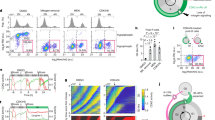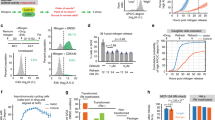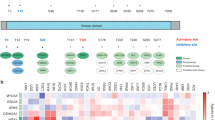Abstract
Ret finger protein-like 1 (RFPL1) is a primate-specific target gene of Pax6, a key transcription factor for pancreas, eye and neocortex development. However, its cellular activity remains elusive. In this article, we report that Pax6-elicited expression of the human (h)RFPL1 gene in HeLa cells can be enhanced by in vivo p53 binding to its promoter and therefore investigated the hypothesis that hRFPL1 regulates cell-cycle progression. Upon expression in these cells, hRFPL1 decreased cell number through a kinase-dependent mechanism as PKC activates and Cdc2 inhibits hRFPL1 activity. hRFPL1 antiproliferative activity led to an increased cell population in G2/M phase and specific cyclin B1 and Cdc2 downregulations, which were precluded by a proteasome inhibitor. Specifically, cytoplasm-localized hRFPL1 prevented cyclin B1 and Cdc2 accumulation during interphase. Consequently, cells showed a delayed entry into mitosis and cell-cycle lengthening resulting from a threefold increase in G2 phase duration. Given previous reports that RFPL1 is expressed during cell differentiation, its impact on cell-cycle lengthening therefore provides novel insights into primate-specific development.
Similar content being viewed by others
Log in or create a free account to read this content
Gain free access to this article, as well as selected content from this journal and more on nature.com
or
Abbreviations
- cPFTα:
-
cyclic-Pifithrin-α
- RDM:
-
RFPL-defining motif
- RFPL:
-
Ret finger protein-like
- RSH:
-
RFPL1,2,3-specifying helix
- SNP:
-
single nucleotide polymorphism
References
Englund C, Fink A, Lau C, Pham D, Daza RA, Bulfone A et al. Pax6, Tbr2, and Tbr1 are expressed sequentially by radial glia, intermediate progenitor cells, and postmitotic neurons in developing neocortex. J Neurosci 2005; 25: 247–251.
Liu W, Lagutin OV, Mende M, Streit A, Oliver G . Six3 activation of Pax6 expression is essential for mammalian lens induction and specification. EMBO J 2006; 25: 5383–5395.
Mellitzer G, Bonné S, Luco RF, Van De Casteele M, Lenne-Samuel N, Collombat P et al. IA1 is NGN3-dependent and essential for differentiation of the endocrine pancreas. EMBO J 2006; 25: 1344–1352.
Bonnefont J, Nikolaev SI, Perrier AL, Guo S, Cartier L, Sorce S et al. Evolutionary forces shape the human RFPL1,2,3 genes toward a role in neocortex development. Am J Hum Genet 2008; 83: 208–218.
Rajkovic A, Lee JH, Yan C, Matzuk MM . The ret finger protein-like 4 gene, Rfpl4, encodes a putative E3 ubiquitin-protein ligase expressed in adult germ cells. Mech Dev 2002; 112: 173–177.
Suzumori N, Burns KH, Yan W, Matzuk MM . RFPL4 interacts with oocyte proteins of the ubiquitin–proteasome degradation pathway. Proc Natl Acad Sci USA 2003; 100: 550–555.
Ledan E, Polanski Z, Terret ME, Maro B . Meiotic maturation of the mouse oocyte requires an equilibrium between cyclin B synthesis and degradation. Dev Biol 2001; 232: 400–413.
Bassermann F, Peschel C, Duyster J . Mitotic entry: a matter of oscillating destruction. Cell Cycle 2005; 4: 1515–1517.
Cartier L, Laforge T, Feki A, Arnaudeau S, Dubois-Dauphin M, Krause KH . Pax6-induced alteration of cell fate: shape changes, expression of neuronal alpha tubulin, postmitotic phenotype, and cell migration. J Neurobiol 2006; 66: 421–436.
Komarov PG, Komarova EA, Kondratov RV, Christov-Tselkov K, Coon JS, Chernov MV et al. A chemical inhibitor of p53 that protects mice from the side effects of cancer therapy. Science 1999; 285: 1733–1737.
Wiznerowicz M, Trono D . Conditional suppression of cellular genes: lentivirus vector-mediated drug-inducible RNA interference. J Virol 2003; 77: 8957–8961.
Clement V, Dunand-Sauthier I, Wiznerowicz M, Clarkson SG . UV-induced apoptosis in XPG-deficient fibroblasts involves activation of CD95 and caspases but not p53. DNA Repair (Amst) 2007; 6: 602–614.
Sansom SN, Griffiths DS, Faedo A, Kleinjan DJ, Ruan Y, Smith J et al. The level of the transcription factor Pax6 is essential for controlling the balance between neural stem cell self-renewal and neurogenesis. PLoS Genet 2009; 5: e1000511.
Thomas M, Pim D, Banks L . The role of the E6–p53 interaction in the molecular pathogenesis of HPV. Oncogene 1999; 18: 7690–7700.
Lindqvist A, van Zon W, Karlsson Rosenthal C, Wolthuis RM . Cyclin B1-Cdk1 activation continues after centrosome separation to control mitotic progression. PLoS Biol 2007; 5: e123.
Solomon MJ, Glotzer M, Lee TH, Philippe M, Kirschner MW . Cyclin activation of p34cdc2. Cell 1990; 63: 1013–1024.
Yang J, Bardes ES, Moore JD, Brennan J, Powers MA, Kornbluth S . Control of cyclin B1 localization through regulated binding of the nuclear export factor CRM1. Genes Dev 1998; 12: 2131–2143.
Peters JM . The anaphase promoting complex/cyclosome: a machine designed to destroy. Nat Rev Mol Cell Biol 2006; 7: 644–656.
Hsieh YW, Yang XJ . Dynamic Pax6 expression during the neurogenic cell cycle influences proliferation and cell fate choices of retinal progenitors. Neural Dev 2009; 4: 32.
Heins N, Malatesta P, Cecconi F, Nakafuku M, Tucker KL, Hack MA et al. Glial cells generate neurons: the role of the transcription factor Pax6. Nat Neurosci 2002; 5: 308–315.
Suter DM, Tirefort D, Julien S, Krause KH . A Sox1 to Pax6 switch drives neuroectoderm to radial glia progression during differentiation of mouse embryonic stem cells. Stem Cells 2009; 27: 49–58.
Innocente SA, Abrahamson JL, Cogswell JP, Lee JM . p53 regulates a G2 checkpoint through cyclin B1. Proc Natl Acad Sci USA 1999; 96: 2147–2152.
Iwai H, Kim M, Yoshikawa Y, Ashida H, Ogawa M, Fujita Y et al. A bacterial effector targets Mad2L2, an APC inhibitor, to modulate host cell cycling. Cell 2007; 130: 611–623.
Yuan J, Krämer A, Matthess Y, Yan R, Spänkuch B, Gätje R et al. Stable gene silencing of cyclin B1 in tumor cells increases susceptibility to taxol and leads to growth arrest in vivo. Oncogene 2006; 25: 1753–1762.
Xie XH, An HJ, Kang S, Hong S, Choi YP, Kim YT et al. Loss of cyclin B1 followed by downregulation of cyclin A/Cdk2, apoptosis and antiproliferation in HeLa cell line. Int J Cancer 2005; 116: 520–525.
Ubersax JA, Woodbury EL, Quang PN, Paraz M, Blethrow JD, Shah K et al. Targets of the cyclin-dependent kinase Cdk1. Nature 2003; 425: 859–864.
Santamaria D, Barrière C, Cerqueira A, Hunt S, Tardy C, Newton K et al. Cdk1 is sufficient to drive the mammalian cell cycle. Nature 2007; 448: 811–815.
Listovsky T, Zor A, Laronne A, Brandeis M . Cdk1 is essential for mammalian cyclosome/APC regulation. Exp Cell Res 2000; 255: 184–191.
Menendez D, Krysiak O, Inga A, Krysiak B, Resnick MA, Schönfelder G . A SNP in the flt-1 promoter integrates the VEGF system into the p53 transcriptional network. Proc Natl Acad Sci USA 2006; 103: 1406–1411.
Menendez D, Inga A, Snipe J, Krysiak O, Schönfelder G, Resnick MA . A single-nucleotide polymorphism in a half-binding site creates p53 and estrogen receptor control of vascular endothelial growth factor receptor 1. Mol Cell Biol 2007; 27: 2590–2600.
Agarwal MK, Ruhul Amin AR, Agarwal ML . DNA replication licensing factor minichromosome maintenance deficient 5 rescues p53-mediated growth arrest. Cancer Res 2007; 67: 116–121.
Pandit B, Halasi M, Gartel AL . p53 negatively regulates expression of FoxM1. Cell Cycle 2009; 8: 3425–3427.
Chauhan BK, Reed NA, Zhang W, Duncan MK, Kilimann MW, Cvekl A . Identification of genes downstream of Pax6 in the mouse lens using cDNA microarrays. J Biol Chem 2002; 277: 11539–11548.
Oren M . Decision making by p53: life, death and cancer. Cell Death Differ 2003; 10: 431–442.
Wolf LV, Yang Y, Wang J, Xie Q, Braunger B, Tamm ER et al. Identification of pax6-dependent gene regulatory networks in the mouse lens. PLoS One 2009; 4: e4159.
Deshaies RJ, Joazeiro CA . RING domain E3 ubiquitin ligases. Annu Rev Biochem 2009; 78: 399–434.
Zhang G, Wang G, Wang S, Li Q, Ouyang G, Peng X . Applying proteomic methodologies to analyze the effect of hexamethylene bisacetamide (HMBA) on proliferation and differentiation of human gastric carcinoma BGC-823 cells. Int J Biochem Cell Biol 2004; 36: 1613–1623.
Dehay C, Kennedy H . Cell-cycle control and cortical development. Nat Rev Neurosci 2007; 8: 438–450.
Gotz M, Huttner WB . The cell biology of neurogenesis. Nat Rev Mol Cell Biol 2005; 6: 777–788.
Kuan CY, Roth KA, Flavell RA, Rakic P . Mechanisms of programmed cell death in the developing brain. Trends Neurosci 2000; 23: 291–297.
Green DR, Kroemer G . Cytoplasmic functions of the tumour suppressor p53. Nature 2009; 458: 1127–1130.
Suter DM, Cartier L, Bettiol E, Tirefort D, Jaconi ME, Dubois-Dauphin M et al. Rapid generation of stable transgenic embryonic stem cell lines using modular lentivectors. Stem Cells 2006; 24: 615–623.
Bonnefont J, Daulhac L, Etienne M, Chapuy E, Mallet C, Ouchchane L et al. Acetaminophen recruits spinal p42/p44 MAPKs and GH/IGF-1 receptors to produce analgesia via the serotonergic system. Mol Pharmacol 2007; 71: 407–415.
Livak KJ, Schmittgen TD . Analysis of relative gene expression data using real-time quantitative PCR and the 2(-Delta Delta C(T)) Method. Methods 2001; 25: 402–408.
Acknowledgements
JB was supported by the Auvergne Regional Council, the Geneva Department of Public Education and FP7-2007 ICT-216593 (SECO). CD was supported by FP7-2007 ICT-216593 (SECO) and ANR-06-NEUR-010. KHK was supported by the Swiss National Science Foundation.
Author information
Authors and Affiliations
Corresponding author
Ethics declarations
Competing interests
The authors declare no conflict of interest.
Additional information
Edited by M Oren
Supplementary Information accompanies the paper on Cell Death and Differentiation website
Rights and permissions
About this article
Cite this article
Bonnefont, J., Laforge, T., Plastre, O. et al. Primate-specific RFPL1 gene controls cell-cycle progression through cyclin B1/Cdc2 degradation. Cell Death Differ 18, 293–303 (2011). https://doi.org/10.1038/cdd.2010.102
Received:
Revised:
Accepted:
Published:
Issue date:
DOI: https://doi.org/10.1038/cdd.2010.102



